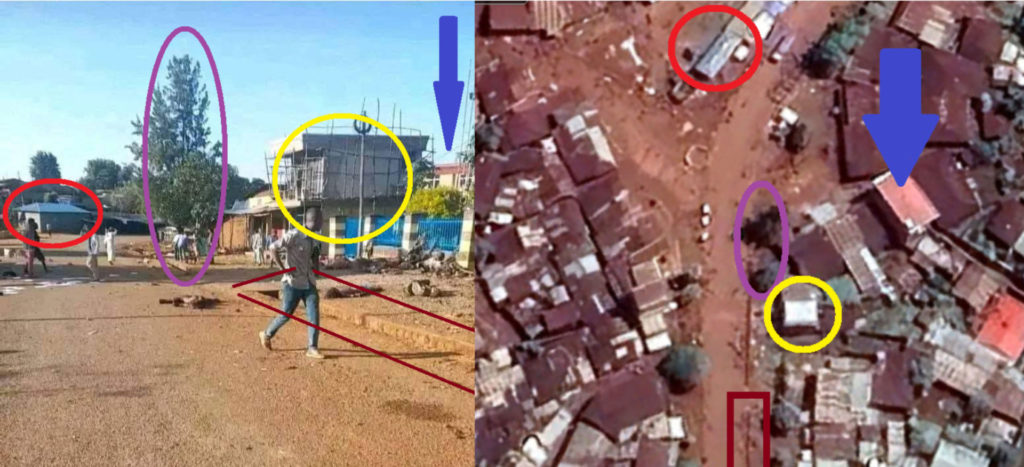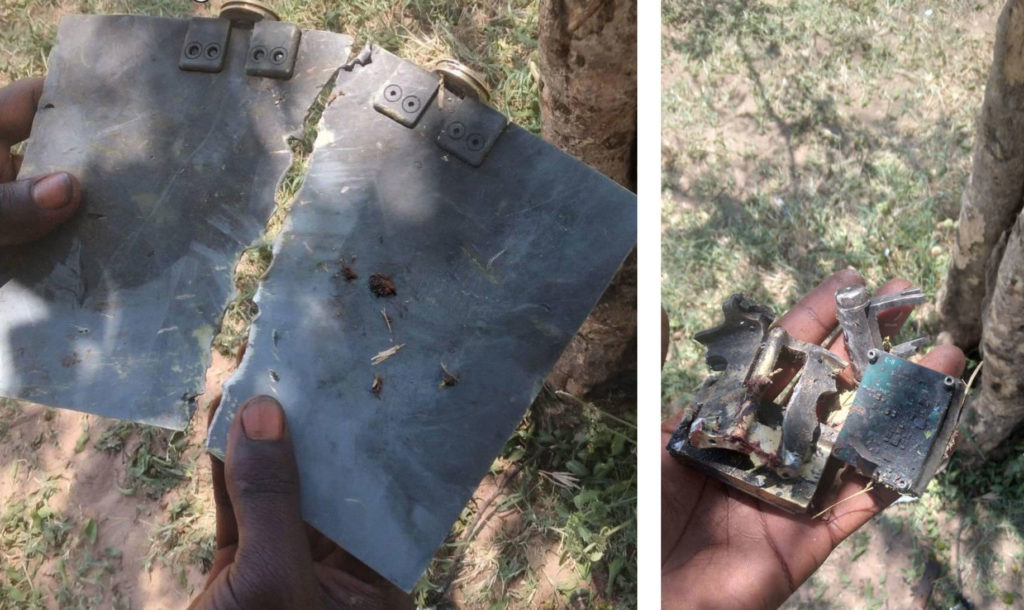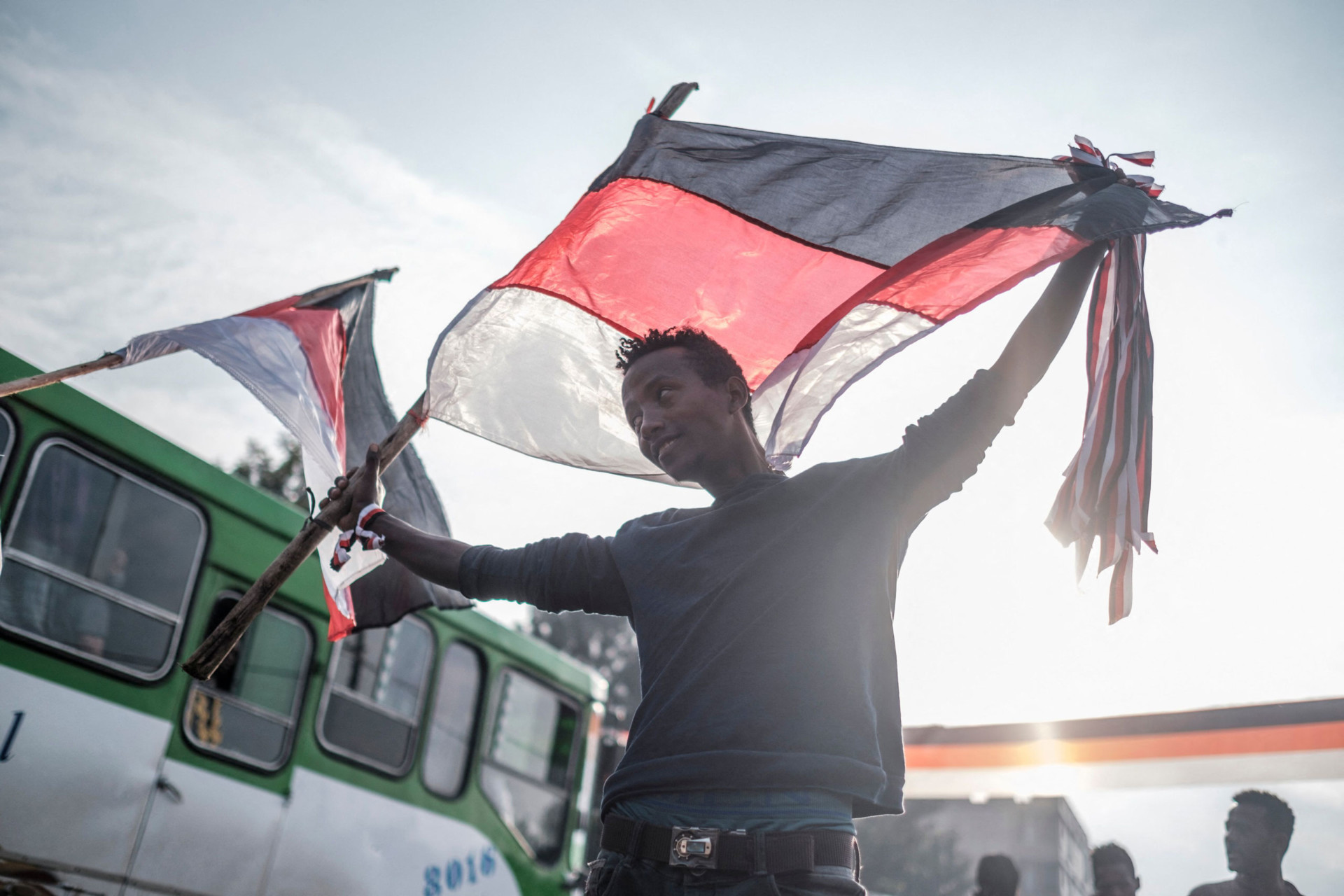On the morning of Nov. 2, the Ethiopian town of Bila, about 300 miles west of the capital, Addis Ababa, was bustling as people went about their shopping and commuted to school and work. Within seconds, the scene was transformed into chaos, as munitions launched by drones ripped through a busy transport hub, killing dozens of civilians.
“I saw young students in uniform among the bodies,” an eyewitness, whose name is being withheld for safety concerns, told New Lines.
As the injured screamed in agony, panicked bystanders fled the area, fearing a possible follow-up strike, according to two eyewitnesses. Neither said there were any legitimate military targets in the area.
“Since that day, people here are even scared of the sight of planes in the sky,” one of the eyewitnesses said.
Over the past three months, dozens of strikes like the one in Bila have become a new feature in an escalating conflict in Ethiopia’s Oromia Region, as the government deploys a fleet of armed drones to combat what it says are armed insurgents. Scores of civilians have been killed in Oromia, Ethiopia’s largest region, which is home to over a third of the country’s 120 million people.
Officials have kept tight-lipped about the strike and journalists are prohibited from visiting rebel-held towns like Bila. Yet harrowing accounts of what happened in Bila trickled onto social media. A two-minute video shows dozens of bodies strewn along the side of the road; a man wails as shocked bystanders, speaking in Oromo, examine the remains of the dead. The video and photographs from the attack have been shared hundreds of thousands of times.
New Lines geolocated the images to a central area of the town of Bila, only a few hundred yards from the town’s main bus terminal and its town hall. The surroundings captured in the footage appear consistent with eyewitness descriptions of the area hit by the drone, including its proximity to a bank and St. Gabriel Church. Analysis of the clip found no evidence that it had been doctored or tampered with.

Though Ethiopia is led by the Nobel Peace Prize laureate Prime Minister Abiy Ahmed, recent years have seen the country become synonymous with war. The conflict in Oromia preceded the civil war in Tigray, but the brutality in Tigray has overshadowed the Oromia story. Researchers estimate the war in Tigray has led to over half a million deaths. Before a cease-fire agreement ending fighting in Tigray in November, experts had expressed fears that the conflict could lead to genocide.
One year after his 2018 appointment as prime minister, Abiy won the Nobel for his part in ending political hostility with neighboring Eritrea and releasing tens of thousands of political prisoners. The move spurred the United Arab Emirates to transfer billions of dollars to Ethiopia, which has been strapped for foreign currency, while U.S. lawmakers on both sides of the aisle sang Abiy’s praises.
There were great expectations at home as well for Abiy, who is Oromo. Years of paralysis and anti-government uprisings ignited largely by Oromo youth protesters, widely known as Qeeroo, had left the country unstable and tense.
The uprisings had forced the end of nearly three decades of autocratic rule by ethnic Tigrayan elites. Abiy had promised exiled Oromo activists and armed militants the right to return home without facing persecution.
Many took up the offer, including leaders of the Oromo Liberation Front (OLF), which was decriminalized as an organization. Despite a hero’s welcome in the Ethiopian capital for returning OLF leaders and fighters in August 2018, talks aimed at the OLF’s disarmament and reintegration as a political party eventually hit a dead end.
By early 2019, the OLF’s armed wing had severed ties with its political leadership and resumed fighting under the name Oromo Liberation Army (OLA), with military commander Jaal Marroo as its leader. In response, Abiy launched an offensive against the OLA.
The former U.N. peacekeeper began to gradually walk back some of his most feted reforms. From early 2020, crackdowns on Ethiopia’s independent press and political opposition landed thousands behind bars.
Observers have suggested that seemingly unconditional American praise and support may have emboldened Abiy to eliminate rivals at home. Having deployed his military to crush armed uprisings in multiple war zones across the country, Abiy’s forces have carried out numerous atrocities, including ethnic cleansing and weaponized rape, with some experts expressing fears that crimes committed by his troops in Tigray may amount to genocide.
It’s a far cry from what was anticipated of the Nobel laureate. Since 2019, war crimes have resulted in Ethiopia’s being hit with a European Union budget freeze as well as its removal from a lucrative American trade treaty.
In Tigray, fighting has died down considerably since November’s cease-fire. But things are only intensifying in Oromia, home to rebel fighters from the OLA. In recent months, Abiy’s weapon of choice in dealing with the insurrection has been the armed drone.
Cheaply procured from the likes of Iran, the UAE and Turkey in 2021, Ethiopia’s arsenal of unmanned aircraft killed over a hundred civilians in Tigray during two weeks in January this year, including at least 50 at a camp for displaced people. Now deployed once again, the drones have exacerbated human suffering across Oromia, a region also ravaged by drought and communal violence.
Initially a lower-scale insurgency, fighting in Oromia has over the past three years escalated into a war of attrition that has seen atrocities, mass displacement of civilians and control of territory change hands repeatedly. Thousands, if not tens of thousands, are estimated to have lost their lives.
Bogged down by fighting across northern Ethiopia, government forces have made little progress in the west of the country. The launch of a much-hyped “final” offensive by the Ethiopian military earlier this year has failed to yield the rebels’ capitulation. Last month, OLA fighters reportedly captured two additional towns in western Ethiopia, including Mendi, where they ransacked banks and kidnapped administrative officials.
Though the Ethiopian air force claims its bombing runs on suspected OLA strongholds have taken place since 2019, until recently they were relatively rare. A recent proliferation of drone technology has led to a considerable increase in aerial attacks.
In October, Ethiopia began ramping up its aerial campaign targeting rebel-held parts of Oromia with drone strikes, in response to OLA advances across the region’s Western Shewa district. It is civilians, however, who have borne the brunt of the strike-related casualties.
On Oct. 22, a drone strike targeted a public gathering at a school compound outside the town of Ch’obi, 90 miles northwest of Addis Ababa. Survivors describe it as a massacre of unarmed civilians.
“This is unbecoming: Women, children and elderly as old as 80 have perished for no apparent reason,” said Gutu Deressa, an eyewitness of the carnage reached one week after the attack. (Deressa and other witnesses’ names have been changed to protect their identities.)
“So far, we have recorded the deaths of 86 people, but many were injured and I suspect the number to be higher.”

Gemechu Abdissa, 64, who resides in a farming community in the area, explained to New Lines that, on the day of the strike, a community meeting had been convened by elders to discuss the deteriorating security and economic woes.
“Around 11 a.m., drones began hovering over us. Then the bombs began exploding,” Gemechu recalled. “Frightened people began running in different directions, desperate for shelter of any kind; some hid under trees. It was much later, long after things had quieted down, that people returned to search for the missing and identify the dead.”
“We treated dozens of civilians … including some who later succumbed to their injuries,” said a health worker at a clinic in Ch’obi, who requested anonymity for security reasons.
“Our clinic received 15 to 20 dead and mutilated bodies,” said the health worker, adding that victims had sustained injuries including burns and lacerations from the blasts.
Oromia regional security bureau officials did not respond to requests for comment. Government officials have thus far released no public statements on the recent uptick of drone activity in Oromia.
Since the Oct. 22 strike at Ch’obi, around a dozen more deadly drone strikes have been reported, including one on Nov. 9 in the town of Mendi. Residents reached by New Lines confirmed that while the series of strikes in early November coincided with an uptick in fighting between rebels and government forces, there were children returning home from school among the fatalities.
According to the region’s main political opposition party, the Oromo Federalist Congress, hundreds of people died in four separate drone strikes on rebel-held towns and villages between Oct. 19 and Oct. 23. In its own reporting of multiple drone strikes across the same time period, the BBC put the death toll at 70.
A devastating drought that has ravaged crops across East Africa has exacerbated the situation in the region. The World Food Program estimates the drought has left 10 million people across western and southern Ethiopia in need of emergency food aid. In August, the OLA proposed a regionwide cease-fire to allow humanitarian agencies to deliver food assistance to drought-impacted populations. The government did not respond to the offer.
Food shortages and violence across Oromia have contributed to Ethiopia’s grim world record of 5.1 million internally displaced people in a single calendar year (2021).
The Ethiopian army’s manhunt for Jaal Marroo and its attempt to pacify the region have led to the deaths of scores of people suspected of affiliation or sympathy with the OLA. By 2020, Amnesty International had accused Ethiopian troops and the Oromia Special Police, a government-funded regional paramilitary force, of normalizing mass detention, extrajudicial killings and torture.
“The targeting of civilians in aerial bombardments highlights the sort of war tactics the [Ethiopian] regime has chosen to pursue,” said Etana Habte, an analyst of Ethiopian affairs and assistant professor of history at James Madison University in Virginia.
“As the OLA has engaged in guerrilla warfare and government forces have been unable to defeat them as of yet, [the Ethiopian military] is apparently convinced that hitting the civilian population, perceived to be supporting and hosting the OLA, is the best approach.”
For its part, OLA rebels have been accused of a slew of kidnappings and assassinations of local officials, as well as the planning and carrying out of massacres of the region’s ethnic Amhara minority. Among the most notorious of these took place on June 18 of this year, when over 300 civilians were killed.
Both the OLA and the Ethiopian government deny involvement in any atrocities, typically blaming each other when reports of mass killings emerge.
In recent months, reports of irregular militias from neighboring Amhara ransacking towns in Oromia and killing residents have increased with alarming frequency. The state-backed Ethiopian Human Rights Commission accused militants of carrying out cross-border raids that killed scores and displaced up to 20,000 people in late August. Locals, meanwhile, say the militants are members of “Fano,” an ethnic Amhara militia group that has previously fought alongside the Ethiopian army.
At least 700,000 people recently displaced from their homes in parts of the Oromia region need food assistance, according to a UNOCHA report published in November, which cited “ongoing hostilities in western Oromia” as triggering the exodus.
Verifying the claims and counterclaims from Oromia is often complex, as insecurity, communications shutdowns and war-induced road closures render much of the region inaccessible. Journalists are barred from traveling to rebel-held areas and have been punished for doing so.
As with the war in Tigray, journalists have relied on satellite imagery and leaked footage from the region to unearth facts about allegations.
The geolocated footage of the Bila massacre has served to substantiate growing claims by Oromo rights activists that drone operators have also targeted densely populated urban areas indiscriminately.
“Drones are supposed to target military operations, convoys or training facilities. The one in Bila absolutely targeted civilians,” said Samuel Bekele, an Oromo rights activist and son of prominent opposition party politician Bekele Gerba, who himself hails from Bila.
“The fact that it landed close to a bus station says a lot about who the targets were. You have to be extra careful conducting operations on the ground, let alone from unmanned drones thousands of feet above the ground.”
Meanwhile, images have surfaced of what OLA spokesman Odaa Tarbii claims are parts from a Turkish drone bomb used in the Oct. 22 Ch’obi strike. New Lines could not independently verify the authenticity of the images, but showed them to Amelia Smith, a U.S. defense analyst and military drones expert, who said they appeared to show the tailfins of a MAM-L — a Turkish-made, laser-guided bomb.
Smith explained that MAM-Ls are capable of considerable precision — landing within 45 feet of their locked target — which would make the likelihood of a misguided strike hitting unintended targets small. “It’s unlikely that such a strike would miss its intended target and hit a crowd,” she said.
Billene Seyoum, a spokesperson for Abiy, did not respond to an emailed request for comment on Smith’s assessment and evidence of a drone strike targeting civilians in Bila.
As swaths of Oromia approach a fourth anniversary of war, drones may tragically prove a far more cost-effective method of ensuring slaughter continues unabated. For communities heading into the new year, cut off from a world increasingly accustomed to human suffering far away from Western shores, the outlook appears grim.




